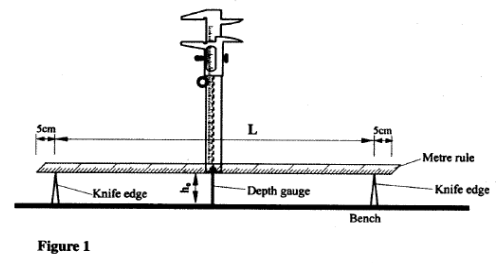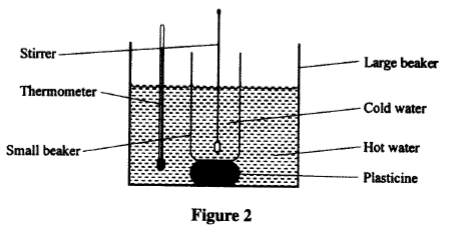QUESTIONS
- You are provided with the following:
-Metre rule;
-Vernier calipers;
-A 300 g mass;
-Two knife edges;
-Some thread.
Proceed as follows:- Place a metre rule on the knife edges such that each knife edge is 45 cm from the 50 cm mark (centre of the rule). See figure 1. Ensure that all the millimeter scale of the metre rule is facing upwards. The distance L between the knife edges is now 900 mm.
Place the vernier calipers vertically against the metre rule at the 50 cm mark with the depth gauge lowered to touch the bench as shown in figure 1.
Record the height, ho, of the upper edge of at the 50 cm mark.
(See figure 1)
ho = ...... mm (1 mark) - Using the thread provided, hang the 300g mass at the 50 cm mark of the metre rule. Ensure that the mass does not touch the bench. Measure and record in table 1, the height h of the edge of the metre rule at the 50 cm mark.
- With the mass still at the 50 cm mark, adjust the position of the knife edges so that L is now 800 mm. (The knife edges should be equidistant from the centre of the metre rule). Measure and record I table 1 the height h of the edge of the metre rule at the 50 cm mark.
- Repeat the procedure in (c) for other values in L shown in table 1. Complete the table.
- Plot the graph of log L (y-axis) against log d. (5 marks)
- Determine the value of the slope s of the graph. (3 marks)
- Evaluate y = 1/s
y = ……………………. (1 mark) - Determine G, the value of log L, when log d = 0.
G = ………………………… (2 marks) - Given that G =
, determine the value of k.
k = …………….. (1 mark)
- Place a metre rule on the knife edges such that each knife edge is 45 cm from the 50 cm mark (centre of the rule). See figure 1. Ensure that all the millimeter scale of the metre rule is facing upwards. The distance L between the knife edges is now 900 mm.
- You are provided with the following:
-A 100 ml beaker,
-A 600 ml beaker
-Two thermometers range -100C to1100C;
-A measuring cylinder; (to be shared)
-Some plasticine;
-Vernier calipers; (to be shared)
-A metre rule or half metre rule;
-Some boiling water;
-Some cold water; (at room temperature).
-A stopwatch;
-A stirrer.
Proceed as follows:- Using the vernier calipers, measure the internal diameter d1 and the external diameter d2 of the 100ml beaker.
d1 = ………………………..cm
d2 = ………………………..cm (1 mark)
Determine the thickness X of the glass wall of the beaker, given that
X = ………………………cm (1 mark) - Using the measuring cylinder provided, pour 75 ml of cold water into the small beaker. Measure the height h, of the water in the small beaker.
h = ……………cm (1 mark)
Determine the area A of the glass walls in contact with the water, given that
A = πd1h.
A = ……………………….cm2 (1 mark) - Use the plasticine provided to make a circular disc of about the same area as the bottom surface of the small beaker and about 1 cm thick. Place the disc at the bottom of the large beaker and place the small beaker on it.
Now pour boiling water into the large beaker until the levels of the water in the two beakers are the same. See figure 2. - Place a thermometer in the hot water and stir gently until the temperature drops to 750C. Now start the stopwatch and measure the temperature T1 of the hot water at intervals of 20 seconds. Record the readings in table 2.
(Stir the water in the two beakers before taking the readings).
Pour out the contents of the two beakers. - Measure another 75 ml of cold water and put it into the small beaker. Place the small beaker into the large beaker on the plasticine as before.
Again pour boiling water into the large beaker until the levels of the water in the two beakers are the same. Place one thermometer in the cold water and the other in the hot water. Stir gently until the temperature of the hot water drops to 750C. Start the stop watch immediately read and record in table 2 the temperature T2 of the cold water.
(You may now remove the thermometer in the cold water).
Read other values of T2 at intervals of 20s and record in table 2. - Plot a graph of temperature T2 (y-axis) against time. (5 marks)
- Determine the slope S of the graph at time t = 60 seconds. (3 marks)
- Determine the constant k, given that
where T1 and T2 are the temperatures of the hot and the cold water at t = 60s, and X and A are in m and m2 respectively. (2 marks)
- Using the vernier calipers, measure the internal diameter d1 and the external diameter d2 of the 100ml beaker.
MARKING SCHEME
-
- ho (d) = 85.0-99.0mm
Atleast 1 d.p(must) 1mk -
L(mm) 900 800 700 600 500 h(mm) 76.0-90.0 78.0-92.0 80.0-94.0 83.0-97.0 85.0-99.0 1dp 1mk for max 4 values depression d (mm) Exact subtraction >4 values 1 mk < 4-0 log L 2.95 2.90 2.84 or 5 2.7/8 2.69or 70 3sf < 4 values 1 mk < 4-0 log d candidates own values > 4 values 1 mk < 4-0 - Graph, Axes with no units 1mk
Scale (simple and uniform) 1mk
Plotting within 1 small square 2mks @ 1/2 for max. 4 values
Line: Drawn with ruler
: + ve gradient
: Through at least 3 correctly plotted points -
- At least one point correctly plotted on the graph.
Correct intervals 1mk correct evaluation (2 dp) 1mk.
Accuracy 0.13-0.53 1mk - Correct substitution 1/2mk. Correct evaluation 2dp 1/2 mk.
- Extrapolation of candidates line 1/2 mk
(Accept continuous or broken line)
Correct reading when log d = 01/2 mk.
(Ignore units if given)
Accuracy 2.5 - 2.7 1d.p 1mk
Or Forming of two equations 1/2 mk
Solving for C = G1/2mk
Accuracy 2.5 -2.7 1mk - Correct substitution 1/2 mk 2dp a must
Correct evaluation 1/2 mk
(To the nearest whole number or to 1 dp in std. form)
- At least one point correctly plotted on the graph.
- ho (d) = 85.0-99.0mm
-
- d1 = 4.18 - 5.18cm 1/2 mk 2dp a must
d2 = 4.50 -5.58cm 1/2mk
X = d2 - d1 candidate's substitution 1/2 mk
2
Correct evaluation 2sf 1/2 mk - h = 3.8 - 5.4cm 1dp must imk
A = πd1h substitution 1/2 mk
Evaluation 1dp in the range 60 -72 1/2 mk - Temperatures above 80° are not acceptable
-
Accept repreated values of T1 and T2 as from 140sec to 180secT(s) 0 20 40 60 80 100 120 140 160 180 T1ºc 70-80 69-79 67-77 64-74 62-72 61-71 60-70 59-69 58-68 57-67 1/2 mark for max of 6 values T2ºc 32-42 36-46 40-50 44-54 47-57 49-59 50-60 51-61 52-62 53-63 1/2 mark for max of 6 values - Graphs temperatures above 80°C are not acceptable.
Axes with units or units only 1mk
Scale: simple and uniform 1mk
Plotting: alleast 4 points 2mks
Curve 1mk smooth drawn with free hand through at least 4 correctly plotted points in the expected trend.
Accept repeated values for plotting as from 140sec also as part of curve. -
- Whatever the trend;
Tangent drawn at t= 60sec 1mk
Correct intervals 1mk correct evaluation 2sf 1mk - Correct substitution 1mk
(Accept mixed units at the substitution stage only)
Correct evaluation 3sf in the expected or Sf unit 1mk
For wrong Tz check from the graph and accept it.
- Whatever the trend;
- d1 = 4.18 - 5.18cm 1/2 mk 2dp a must
Join our whatsapp group for latest updates
Tap Here to Download for 50/-
Get on WhatsApp for 50/-
Download KCSE 2010 Physics Paper 3 Questions with Marking Scheme.
Tap Here to Download for 50/-
Get on WhatsApp for 50/-
Why download?
- ✔ To read offline at any time.
- ✔ To Print at your convenience
- ✔ Share Easily with Friends / Students







